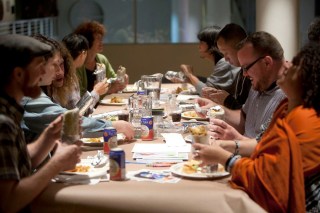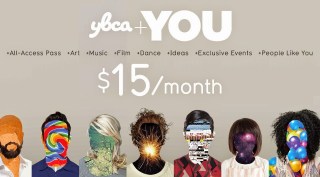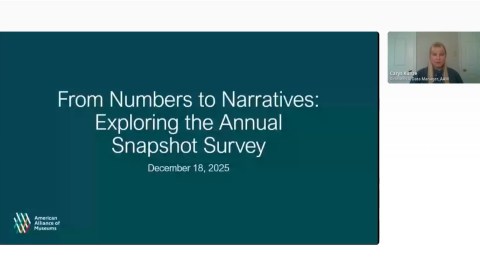
In TrendsWatch 2015 I cite YBCA:You as an example of personalized museum services, one which integrates individualized curricula into a membership-based community engagement program. But (as with so many great museum programs) most of what I know about the project I gleaned from the web. This week, Julie Potter, Creative Ecosystems Senior Program Manager at the Yerba Buena Center for the Arts, shares more details about this program, now in its third year.
YBCA:You
Conceived by Director of Community Engagement Joel Tan, YBCA:You was developed through various pilot ideas addressing the visitor experience with the goal of building deeply engaged and ongoing relationships with participants by increasing the frequency, diversity and community of art-going. Just as one might work with a personal trainer at a gym to improve physical health, YBCA:You fosters one’s artistic, creative and social health with the help of a caring and skilled guide.
 The Invitation – Access
The Invitation – AccessThe first benefit is an All-Access Pass to film, performance and visual art programs at YBCA. This “all-you-can-art” benefit encourages YBCA:You members, or “YOUers”, to more frequently engage. The pass removes the barrier to risk taking or trying something new to which they may not have bought an individual ticket. In this way, the arts center becomes more like a creative gym, a learning haven and a community hotspot.
The Social – Community
The second benefit includes YBCA:You exclusive programs, open just to YOUers, which provide opportunities to meet other arts lovers while gathering around culture. These programs have become communities of practice responding to art with their own unique social architecture and ritual. They are often intimate (no more than 30 or so people at a time) and include food and drink, a culture of openness and respect, as well as modeling behavior and co-teaching. Friendships are formed, social learning occurs and tools for processing art are developed. After all, in today’s digital world getting people talking in a room together can be a radical thing. My background is in performance and I’m partial to encounters in real life.
The participatory nature of YBCA:You exclusive programs invites an active response or feedback loop with the art. Experiential components of the art encounter are highlighted through embodiment, facilitated discussion, play and discovery. The contextual content often illuminates the cultural, social and historical elements or themes of the work. Additionally, many of these exclusives are process driven. Since contemporary art frequently addresses process as well as product, going behind the scenes offers opportunities to examine the full life cycle of an artistic work as well as the ongoing practices of artists. We build in opportunities for meaning-making to support individual and group processes, guiding sense perception, reflection, creation of emergent narratives and layering of ideas.
The Personal – Relationship Management
 The third benefit of YBCA:You is the opportunity to build a one-on-one relationship with program staff serving as what we call a Live Guide. It’s like having a coach for your art life, a sort of librarian, concierge or creative case manager. The Live Guide is an experienced and caring arts educator who learns about members, their values, experiences, wants and dislikes, and helps identify art goals and resources, providing tailored referrals to YBCA programs and other cultural organizations and venues. The interaction draws loosely from the case management model used in social work, as well as Rogerian human-centered therapy communication approaches.
The third benefit of YBCA:You is the opportunity to build a one-on-one relationship with program staff serving as what we call a Live Guide. It’s like having a coach for your art life, a sort of librarian, concierge or creative case manager. The Live Guide is an experienced and caring arts educator who learns about members, their values, experiences, wants and dislikes, and helps identify art goals and resources, providing tailored referrals to YBCA programs and other cultural organizations and venues. The interaction draws loosely from the case management model used in social work, as well as Rogerian human-centered therapy communication approaches. When someone joins the program they can go through an intake process in which our program staff asks questions about the participant’s current and desired relationship to art. What disciplines or content do they gravitate toward? What are they curious about? What venues do they frequent? What time do they have available to braid art into their life? The goal is to distill the desired modalities, subjects and style for that individual.
After the initial meeting, program staff sends personalized recommendations for activities both at YBCA and offsite in the larger Bay Area ecosystem. The Live Guide relationships develop organically from there based on the needs and interest of the member. In general the personalized sessions occur most frequently during onboarding, after someone first joins. Once YOUers become more comfortable navigating their art life, they move toward self-directed participation.
In addition to scheduled Live Guide appointments, YBCA:You offers monthly drop in “Happy/Office Hours” to accommodate the different schedules and preferences of members at a Free Advice booth (think Lucy from Charlie Brown.) The incorporation of individualized curricula or “Artistic Development Plans” at YBCA reflects institutional values of providing customized programming to enhance creative agency and meaning-making for broad and diverse constituencies.
A Three Pronged Approach to Wellness
 Any combination of the three benefits are intended to make art a habit in one’s life with the idea that increased frequency of cultural participation, increased diversity in one’s exploration of arts and ideas, and social modes of engagement result in healthier and happier individuals. These components combined offer breadth and depth. YOUers enjoy the combination of art, community, accessibility and value.
Any combination of the three benefits are intended to make art a habit in one’s life with the idea that increased frequency of cultural participation, increased diversity in one’s exploration of arts and ideas, and social modes of engagement result in healthier and happier individuals. These components combined offer breadth and depth. YOUers enjoy the combination of art, community, accessibility and value. The program costs $15 for the general public and we offer a limited number of free, year long YBCA:You memberships to those who qualify for the subsidy program, which provides benefits to any low income resident (which in San Francisco translates to anyone earning less than $39,600).
The Evolution – Towards a Creative Ecosystem
YBCA:You cuts across age and economics. Most members are highly educated and fit the profile of students in an evening division or continuing education program. These are people taking ownership for their growth and wellness and we’re meeting them where they’re at. The result is that participants feel welcome at YBCA, which cultivates loyalty and a valuable constituency of ambassadors. As in social work, people move from an individual program to interacting with a group, to then linking subgroups and mobilizing to affect. In this way we hope to also foster an artistic citizenship.
At YBCA we are intentional about developing cohorts and networks of belonging through a culture of invitation. What is the structure of belonging? Of wellness? Of inquiry? To belong is to be in a relationship containing both the experience of feeling valued and accepted, and the perception that we somehow complement the system or environment.
Whether social work or arts work, the common thread is the power to facilitate well-being, desired change and self-determination. Moving forward we’re looking to expand the ways YOUers connect with other cohort groups hosted at the museum and further develop pathways of stewardship. We’re fostering a creative ecosystem that looks at human rights through a lens of creativity, utilizing skills, strategies and ideas of planned change from public health and social justice to engage communities through art.
To quote Lois Silverman’s writing about social work of museums:
“The greatest treasures of culture are not sculptures or specimens, but rather human relationships. Magnificent and precious, ourselves, close pairs, families, and groups belong in the worlds museums create, although living culture has quite different needs than rocks or bones. The next age is demanding change of global proportions and a nearly infinite capacity for human caring. Let us meet these needs with courage and creativity, one relationship at a time through the social work of museums.”









